An analysis of 214 species of land animals shows that a creature's ecological niche is a strong predictor of pupil shape. Species with pupils that are vertical slits are more likely to be ambush predators that are active both day and night. In contrast, those with horizontally elongated pupils are extremely likely to be plant-eating prey species with eyes on the sides of their heads. Circular pupils were linked to "active foragers," or animals that chase down their prey.
The study, led by vision scientist Martin Banks, a UC Berkeley professor of optometry, in collaboration with the United Kingdom's Durham University, presents a new hypothesis as to why pupils are shaped and oriented the way they are. The findings will be published Friday, Aug. 7, in the journal Science Advances.
This current research builds upon the foundation set by the late Gordon Walls, a UC Berkeley professor of optometry who published "The Vertebrate Eye and Its Adaptive Radiation" in 1942. The classic text on eye physiology put forward the theory, generally accepted, that slit-shaped pupils allow for different musculature and a greater range in the amount of light entering the eye.
For example, the vertical slits of domestic cats and geckos undergo a 135- and 300-fold change in area between constricted and dilated states, while humans' circular pupils undergo a mere 15-fold change.
Why not diagonal slits?
"For species that are active both night and day, like domestic cats, slit pupils provide the dynamic range needed to help them see in dim light yet not get blinded by the midday sun," said Banks. "However, this hypothesis does not explain why slits are either vertical or horizontal. Why don't we see diagonal slits? This study is the first attempt to explain why orientation matters."
To explain why horizontally elongated pupils, with few exceptions(are there any explanations for the exceptions?), corresponded to grazing prey animals such as sheep, deer and horses, the researchers turned to computer models to study the effects of different pupil shapes.
They found that the horizontal pupils expanded the effective field of view. When stretched horizontally, the pupils are aligned with the ground, getting more light in from the front, back and sides. The orientation also helps limit the amount of dazzling light from the sun above so the animal can see the ground better, the researchers said.
"The first key visual requirement for these animals is to detect approaching predators, which usually come from the ground, so they need to see panoramically on the ground with minimal blind spots," said Banks. "The second critical requirement is that once they do detect a predator, they need to see where they are running. They have to see well enough out of the corner of their eye to run quickly and jump over things."
But what happens to this orientation when the animal lowers its head to graze? If the pupil follows the pitch of the head, they would become more vertical and the theory falters.
"To check this out, I spent hours at the Oakland Zoo, often surrounded by school kids on field trips, to observe the different animals," said Banks. "Sure enough, when goats, antelope and other grazing prey animals put their head down to eat, their eyes rotated to maintain the pupils' horizontal alignment with the ground."
On the other side of the Atlantic, study co-author Gordon Love, a professor of physics at Durham University, found this same pattern when observing sheep and horses at nearby farms. Grazing animals' eyes can rotate by 50 degrees or more in each eye, a range 10 times greater than human eyes, the researchers said.
How ambush predators focus when catching prey
For ambush predators with vertical-slit pupils, the authors noted the importance of accurately gauging the distance animals would need to pounce on their prey. Researchers identified three cues generally used to gauge distance: stereopsis, or binocular disparity; motion parallax, in which closer objects move farther and faster across our field of vision; and blur, in which objects at different distances are out of focus.
The researchers ruled out motion parallax as a factor since using that cue would require head movement that could reveal the predator's position. The remaining two cues, binocular disparity and blur, work together with vertically elongated pupils and front-facing eyes, the researchers said.
Binocular vision works better at judging differences when contours are vertical and objects are at a distance, while blur comes into play for horizontal contours and near-field targets. Vertical-slit pupils maximize both cues, the researchers said.
Vertical pupils are not equally distributed among ambush predators, however.
"A surprising thing we noticed from this study is that the slit pupils were linked to predators that were close to the ground," said William Sprague, a postdoctoral researcher in Banks' lab. "So domestic cats have vertical slits, but bigger cats, like tigers and lions, don't. Their pupils are round, like humans and dogs."
Among the 65 frontal-eyed, ambush predators in this study, 44 had vertical pupils, and 82 percent of them had shoulder heights that were less than 42 centimeters (16.5 inches). Vertical pupils appear to maximize the ability of small animals to judge distances of prey.
The authors explained this by calculating that depth-of-field cues based upon blur are more effective for estimating distances for short animals than tall ones.
"We are learning all the time just how remarkable the eye and vision are," said Love. "This work is another piece in the jigsaw puzzle of understanding how eyes work."
The authors noted that this research focused on terrestrial species. They expect to examine associations of aquatic, aerial and arboreal life on eye position and pupil shape in future studies.
INFORMATION:
Other co-authors of this study are Jürgen Schmoll and Jared Parnell at Durham University.
The National Institutes of Health and the Engineering and Physical Sciences Research Council helped support this research.




